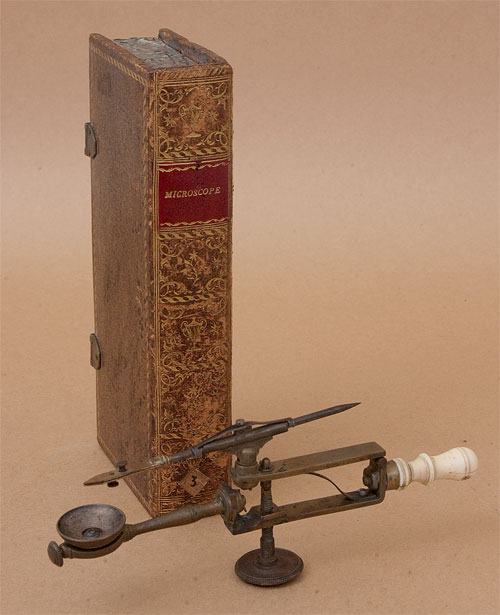 |
|||||
 |
 |
||||
 |
|||||
 |
 |
||||

This instrument is a compass microscope used for field work. It consists of a hinged body with an ivory handle at one end and a turned brass shaft for the objectives on the other. In the center of the instrument is a screwthread mechanism used for focusing the sample. Turning the focus knob moves the sample relative to the fixed objective. To accommodate the change in angle of the top piece relative to the focus mount the threaded shaft has an incorporated U-joint on the sample side. Attached to the top is a mount and mechanism for holding the forceps. The mechanism can be rotated to use either the forceps or pointer. This sample holder is maintained in place with a leaf spring.
Objectives are set into a circular mount at the end of the turned shaft, and held in place with a jam screw. An ivory handle is mounted to the hinge bracket and can be removed for storage. The storage box is made of fruit wood covered with velum that is stamped with intricate gold scrollwork. On the "spline" is stamped at the top "Microscope", and in a diamond on the bottom is the number "3". The case is lined with red velvet and has positions for objectives. Glued to the inside top is a coat of arms from the estate of John Freeman Milward Dovaston Sr (1782-1854). Dovaston Sr. was interested in botany so it is likely that this instrument was used by him in his studies and was housed at his estate "The Nursery" in Twyford, West Felton, Shropshire England. The instrument is 16cm long.
A "Compass Microscope" is a simple magnifier that is hand-held and is hinged at one end, much like a drafting compass. These instruments were used in the field by explorers and lay people alike. Most often they were used for magnifying opaque botanical specimens so they were equipped with a Lieberkuhn reflector. They are the precursor of the modern hand lens.
Microscope featured 02/2015